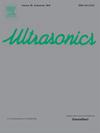Numerical and experimental study of circular array to enhance acoustic tweezer-based particle manipulation
IF 3.8
2区 物理与天体物理
Q1 ACOUSTICS
引用次数: 0
Abstract
Acoustic tweezers enable non-contact, non-invasive manipulation, with promising applications in fields such as biology, micromechanics, and advanced materials. The circular array, commonly used to generate acoustic vortices—an important type of acoustic tweezer—consists of multiple independently addressable elements arranged in a circular configuration. By adjusting the element excitations, the circular array can flexibly control the location of particles. In this study, we employed numerical and experimental methods to analyse the relationship between device geometrical parameters and acoustic field distribution, as well as their impact on particle manipulation. Results from the three-dimensional model indicate that water surface height, array radius, and the material and thickness of the bottom observation layer, significantly influence the acoustic field distribution and, hence trapping performance. Additionally, we used trap stiffness theory to evaluate particle movement capability, and experimentally identified conditions under which trapping may fail, providing theoretical support for improving acoustic tweezer technology.
圆形阵列增强声波镊子粒子操纵的数值与实验研究
声学镊子能够实现非接触、非侵入性操作,在生物学、微力学和先进材料等领域具有广阔的应用前景。圆形阵列通常用于产生声涡流,是一种重要的声镊子,它由多个独立的可寻址元件组成,排列成圆形结构。通过调整元件的激励,圆形阵列可以灵活地控制粒子的位置。在本研究中,我们采用数值和实验方法分析了器件几何参数与声场分布之间的关系,以及它们对粒子操纵的影响。三维模型结果表明,水面高度、阵列半径、底部观测层的材料和厚度对声场分布有显著影响,从而影响捕获性能。此外,我们利用捕获刚度理论来评估粒子的运动能力,并通过实验确定捕获可能失败的条件,为改进声镊子技术提供理论支持。
本文章由计算机程序翻译,如有差异,请以英文原文为准。
求助全文
约1分钟内获得全文
求助全文
来源期刊

Ultrasonics
医学-核医学
CiteScore
7.60
自引率
19.00%
发文量
186
审稿时长
3.9 months
期刊介绍:
Ultrasonics is the only internationally established journal which covers the entire field of ultrasound research and technology and all its many applications. Ultrasonics contains a variety of sections to keep readers fully informed and up-to-date on the whole spectrum of research and development throughout the world. Ultrasonics publishes papers of exceptional quality and of relevance to both academia and industry. Manuscripts in which ultrasonics is a central issue and not simply an incidental tool or minor issue, are welcomed.
As well as top quality original research papers and review articles by world renowned experts, Ultrasonics also regularly features short communications, a calendar of forthcoming events and special issues dedicated to topical subjects.
 求助内容:
求助内容: 应助结果提醒方式:
应助结果提醒方式:


